Exact Contents of Our Online KDB+ Training Course
We often get asked what is in our online training course.
We do describe this on the course page and in a PDF to be be totally thorough here’s a screenshot of our full listing:
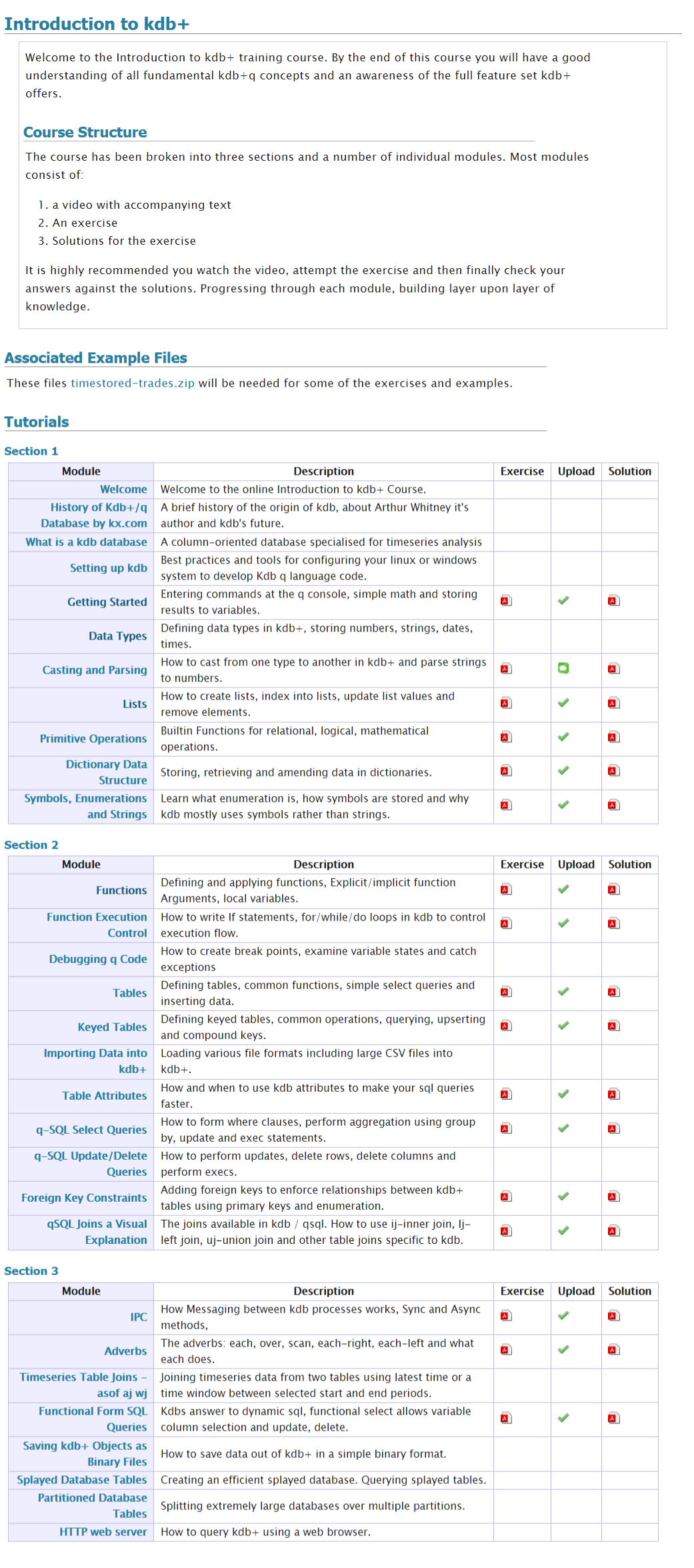
We often get asked what is in our online training course.
We do describe this on the course page and in a PDF to be be totally thorough here’s a screenshot of our full listing:

The biggest shakeup in the KDB world was Arthur Whitney, the founder of KX and creator of KDB selling his stake in KX and moving on to creating a new version of the K language called Shakti. “Shakti merges database, language, connectivity and stream processing into one powerful platform “. So far it appears to overlap heavily with kdb functionality, adding further cryptographic features, while not yet supporting on-disk storage.
FD/KX Products:
First Derivatives Shares have fell back to a price last seen in February 2017:

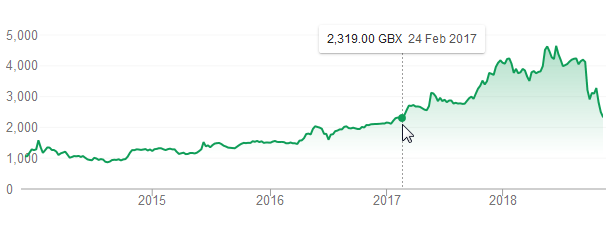
One cause of the fall has been a damning article by ShadowFall. Their main arguments are:
The 47 page report goes into a lot of detail, to give an idea here’s one of the charts:
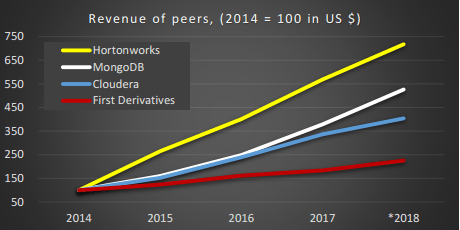
He shows numerous statistics for FD compared to it’s peers, operating margin, gross margin, revenue, headcount. It’s worth a read if you have an interest in kdb/KX/FD.
Related Links: Shadowfall tweet, Independent.ie.
qStudio 1.45 Released, we have:
Some example charts:
Our standard time-series graph interpolates between points. When the data you are displaying is price points, it’s not really valid to always interpolate. If the price was 0.40 at 2pm then 0.46 at 3pm, that does not mean it could be interpreted as 0.43 at 2.30pm. Amazingly till now, sqlDashboards had no sensible way to show taht data. Now we do:
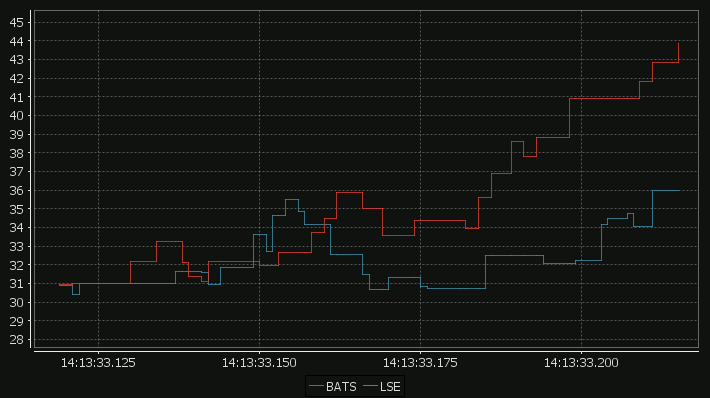
For comparison here is the same data as a time-series graph:
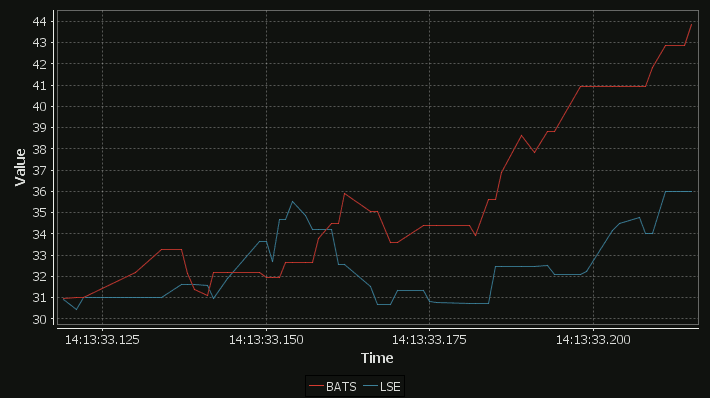
The step-plot is usable for time-series and numerical XY data series. The format is detailed on the usual chart format pages.
qStudio has added support for stacked bar charts:
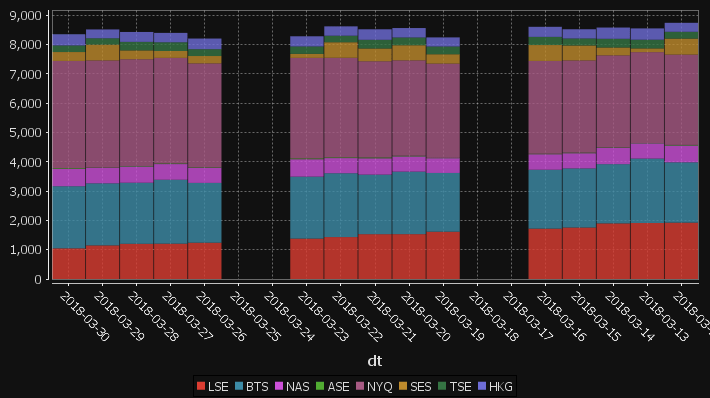
The chart format for this is: The first string columns are used as category labels. Whatever numeric columns appear next are a separate series in the chart. Each row in the data becomes one stacked bar. The table for the data shown above for example is:
| dt | LSE | BTS | NAS | ASE | NYQ | SES | TSE | HKG |
|---|---|---|---|---|---|---|---|---|
| 2018-03-30 | 1047 | 2120 | 592 | 25 | 3660 | 303 | 225 | 383 |
| 2018-03-29 | 1148 | 2118 | 528 | 10 | 3656 | 541 | 215 | 303 |
| 2018-03-28 | 1201 | 2085 | 555 | 17 | 3644 | 302 | 290 | 339 |
| 2018-03-27 | 1206 | 2182 | 535 | 21 | 3604 | 235 | 299 | 319 |
| 2018-03-26 | 1239 | 2041 | 515 | 16 | 3549 | 251 | 234 | 363 |
| 2018-03-25 | 0 | 0 | 0 | 0 | 0 | 0 | 0 | 0 |
| 2018-03-24 | 0 | 0 | 0 | 0 | 0 | 0 | 0 | 0 |
| 2018-03-23 | 1379 | 2115 | 595 | 29 | 3430 | 138 | 251 | 348 |
| 2018-03-22 | 1431 | 2179 | 517 | 25 | 3399 | 531 | 222 | 320 |
| 2018-03-21 | 1530 | 2032 | 558 | 29 | 3282 | 438 | 296 | 359 |
| 2018-03-20 | 1531 | 2134 | 520 | 23 | 3256 | 515 | 265 | 322 |
You may need to “kdb pivot” your original data to get it in the correct shape.
This post is a walkthrough of my implementation in Q of the RosettaCode task ‘Death Star’.
The code is organized as general-purpose bitmap generator which can be used in other projects, and a client specific to the task of deathstar-drawing. The interface is a function which passes a map of pixel position to pixel value. The map can be a mapping function, or alternatively a 2D array of pixel values. The bitmap generator raster-scans the image, getting pixel values from either a mapping function or a mapped array.
genheader follows directly from the referenced BMP Wikipedia article.
genbitmap and genrow perform a raster scan of the image to be constructed. genbitmap steps along the vertical axis, calling genrow, which steps along the pixels of the current line, in turn calling fcn, the pixel-mapping function passed in by the client.
A sample client is included in comments, the simplest possible demonstration of shape and color (a circular mask selecting between two fill colors):
Conveniently, functions and arrays can be equivalently accessed in Q.
Here is an array-passing client which replicates the first example in the Wikipedia article on BMP format.
Element ordering can be confusing at first glance: Byte order for RGB pixels is B,G,R. Also, rows are indexed from bottom to top, and since bitmaps are in row-major order, the first and second array indices designated x and y correspond to the y and x image axes respectively.
After centering the image fcn applies several masks:
is calculates the orientation of a point on a sphere, and then a pixel value for that point, using the dot product of l, the light source direction, and s, the surface orientation. A correction of (1+value)/2 is applied, to achieve the ‘soft’ appearance of a space object in a movie. Alternatively we might have suppressed negative illumination values, to get the high-contrast appearance of an actual space object.
We might want to generate images of the death star at different rotations, however due to some simplifying assumptions we can’t rotate the weapon face to the side without glitching. We calculate z1 and z2 to select between the forward surface of the death star and the rearward surface of the weapon face. We should also calculate z3, the forward surface of the weapon face sphere, and z4, the rearward surface of the death star:
z3:170+z[x2;y;r];
z4:-z1;
Then the masks can be modified so that when z3 > z1 > z4 > z2, an additional bit of background is visible through the carved-out chunk of the deathstar.
TODO: discuss limitations of mask-and-fill; alternative approaches; display-list; …
TODO: discuss animation; …
TODO: discuss three-component architecture: orchestrator, world, bitmap generator
TODO: … conclusions
I often get asked what open source alternatives are there to kdb+. The answer depends on what you are trying to do. IF there was a product XYZ that provided some similar features, whether it can replace kdb depends on a few issues:
>>”What will XYZ bring us that kdb doesn’t?”
Kdb has been tried and tested over many computer/man-years. The KX team have fixed 1000’s of edge cases, optimization issues and OS specific bugs. Any similar system would have to replicate a lot of that work. Possible but it would take time and teams actually using it. It would also require a corporate entity to provide support and bug fixes together with long term guarantees of availability (not a few part-time committers on github). Ontop of that it would need to deliver more value to make it worth switching.
Kdb is both a database and a programming language and it’s that combination which I believe gives kdb it’s unique power:
– There is no open source database that provides the speed kdb provides for the particular queries suited to finance.
– Combining kdb and basing queries on q-sql/ordered lists (rather than set theory for standard sql) means queries require fewer lines of code. I believe this expressiveness combined with longer term use of kdb/q changes how you think and allows easily forming queries which many people couldn’t begin to write in standard sql.
– However as much as I think q is a selling point of kdb, I know many others would disagree. It takes a reasonable period of time to convince someone non-standard SQL is beneficial.
What is your use case? e.g. Example Queries to Consider:
1. Select top N by category
http://stackoverflow.com/questions/176964/select-top-10-records-for-each-category
select n#price by sym from trade
2. Joining Records on nearest date time:
http://www.bigresource.com/MS_SQL-joining-records-by-nearest-datetime-XsKMeH3t.html
aj[`sym`time;select .. from trade where ..;select .. from quote]
3. Queries dependent on order. (eg price change, subtract row from previous)
http://stackoverflow.com/questions/919136/subtracting-one-row-of-data-from-another-in-sql
select price-prev price from trade....
XYZ would need to support these queries well. Why would I chose XYZ instead of Python/R/J/A+?
Existing (some similar languages) that offer a larger existing user base, more libraries and a proven/stable platform. Unless a way is found to leverage existing languages/libraries XYZ will be competiting for attention against kdb and also python/numpy/julia etc.
>>”bring in the cost factor and should XYZ be considered as a big future player?”
For the target market of kdb the cost is often not the most significant factor in the decision. If kdb can answer questions that other platforms can’t or in a much shorter time, it often adds enough value to make the cost irrelevant. In fact many large firms are happy paying a pricey support agreement for free open source software so that they have someone to (blame) call to resolve an issue quickly.
>>”but could XYZ catch up and begin to be trusted by bigger institutions?”
If XYZ started to be able to answer the three example queries shown above at a reasonable speed multiple perhaps but I consider it unlikely. Kdb is entrenched and for its target use case it is currently unbeatable. Some people may have use cases that don’t need the full power of database and language combined or have other important factors (cost,existing expertise). I think those use cases have viable open source solutions.
First, in case you haven’t heard about it kdb has a standard SQL mode, you can send queries prefixed with s) and they will be interpreted as standard SQL like so:
Notice how the standard “and” syntax worked when I used s) but without it, q’s right to left evaluation causes problems. It’s about now that a lot of people get very excited, they think great I can skip learning that q-sql and use my standard SQL. Sometimes the look of joy on their faces transforms to frustration once they start using it. So let’s look at what works:
| Operation | Works? |
|---|---|
| Standard SQL Inserts | Yes |
| ORDER BY | half works |
| COUNT | Yes |
| DELETE | Yes |
| UPDATE | Yes |
| String matching | slightly works |
| NOT | NO |
| IN | Yes |
| GROUP BY | Yes |
| LIMIT / TOP | NO |
| Date Times | NO |
“ORDER BY” will sort the columns in ascending order, attempting to use DESC has no effect.
Modifying our String query slightly by adding NOT throws an error. My guess is that the interpreter has got confused.
Overall standard SQL support in kdb has got much better. However I would still recommend only using the s) syntax for plugging into an existing jdbc/odbc visualization tool and getting some immediate simple results. For any form of complex queries on strings, joins etc. support is either not there or the result may not be what you expect.